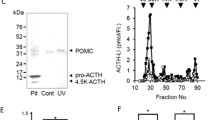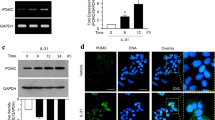Abstract
Proopiomelanocortin (POMC) is known to be synthesized in the pituitary gland and is subsequently cleaved by specific prohormone convertases into biologically active peptide hormones such as melanocyte stimulating hormones (MSH), adrenocorticotropin (ACTH) and endorphins (EP). Guanine nucleotide-binding protein (G-protein)-coupled receptors, which have only recently been discovered, are involved in the transmission of their message. There is also evidence indicating that POMC is not only produced by pituitary cells but is an ubiquitous molecule, that is cleaved cell- and tissue-specific. It has also been shown that the epidermis keratinocytes as well as melanocytes express POMC upon stimulation and release αMSH and ACTH. In addition to their function as hormones, POMC peptides have been shown to exert a variety of immunoregulatory effects by modulating the function of immunocompetent cells as well as cytokines. These findings provide further evidence for the immunoneuroendocrine network playing a crucial role during the pathogenesis of immune and inflammatory skin disease.
Similar content being viewed by others
References
Aebischer I, StÄmpfli MR, Zürcher A, Miescher S, Urwyler A, Frey B, Luger TA, White RR, Stadler BM (1994) Neuropeptides are potent modulators of human in vitro immunoglobulin E synthesis. Eur J Immunol 24: 1908–1913
Arzt E, Buric R, Stelzer G, Stalla J, Sauer J, Renner U, Stalla GK (1993) Interleukin involvement in anterior pituitary cell growth regulation: Effects of IL-2 and IL-6. Endocrinology 132: 459–467
Autelitano DJ, Lundblad JR, Blum M, Roerts JL (1989) Hormonal regulation of POMC gene expression. Annu Rev Physiol 51: 715–726
Batanero E, DeLeeuw FE, Jansen GH, Van Wichen GF, Huber J, Shuurman HJ (1992) The neuronal and neuroendocrine component of the human thymus. Brain Behav Immun 6: 249–255
Bateman A, Singh A, Kral T, Solomon S (1989) The immunehypthalamic-pituitary-adrenal axis. Endocr Rev 10: 92–112
Bhardwaj RS, Aragane Y, Becher E, Schwarz A, Riemann H, Schwarz T, Luger TA (1994) Alpha-melanocyte stimulating hormone differentially regulates interleukin 10 production by human peripheral mononuclear cells. J Invest Dermatol 102: 586
Blalock JE (1992) Production of peptide hormones and neurotransmitters by the immune system. Chem Immunol 52: 1–24
Blalock JE (1994) The immunesystem: our sixth sense. Immunologist 2: 8–15
Brown SL, Blalock JE (1990) Neuroendocrine immune interactions. In: Oppenheim JJ, Shevach EM (eds) Immunophysiology, the role of cells and cytokines in immunity and inflammation. Oxford University Press, Oxford, pp 306–319
Brown SL, Smith LR, Blalock JE (1987) Interleukin 1 and interleukin 2 enhance proopiomelanocortin gene expression in pituitary cells. J Immunol 139: 3181–3183
Burbach JPH, Wiegant VM: (1990) Gene expression, biosynthesis and processing of proopiomelanocortin peptides and vasopressin. In: Wied D de (ed) Neuropeptides: basics and perspectives. Elsevier, Amsterdam, pp 45–103
Cannon JG, Tatro JB, Reichlin S, Dinarello CA (1986) Alpha melanocyte stimulating hormone inhibits immunostimulatory and inflammatory actions of interleukin 1. J Immunol 137: 2232–2236
Catania A, Lipton JM (1993) Alpha-melanocyte-stimulating hormone peptides in host responses. From basic evidence to human research. Ann N Y Acad Sci 680: 412–423
Chakraborty A, Pawelek J (1993) MSH receptors in immortalized human epidermal keratinocytes: a potential mechanism for coordinate regulation of the epidermal-melanin unit. J Cell Physiol 157: 344–350
Chang AC, Israel A, Gazdar A, Cohen SN (1989) Initiation of pro-opiomelanocortin mRNA from a normally quiescent promoter in a human small cell lung cancer cell line. Gene 84: 115–126
Chao CC, Molitor TW, Hu S (1993) Neuroprotective role of IL-4 against activated microglia. J Immunol 151: 1473–1481
Chhajlani V, Wikberg JE (1992) Molecular cloning and expression of the human melanocyte stimulating hormone receptor cDNA. FEBS Lett 309: 417–420
Chhajlani V, Muceniece R, Wikberg JE (1993) Molecular cloning of a novel human melanocortin receptor. Biochem Biophys Res Commun 195: 866–873
Cone RD, Mountjoy KG (1992) Cloning and functional characterization of human adrenocorticotropin receptor. In: Capponi A, Chambaz EM, Mantero F (eds) Cellular and molecular biology of the adrenal cortex. J Libbey Eurotext, Paris, pp 27–40
Daynes RA, Robertson BA, Cho BH, Burnham DK, Newton R (1987) Alpha-melanocyte-stimulating hormone exhibits target cell selectivity in its capacity to affect interleukin 1-inducible responses in vivo and in vitro. J Immunol 139: 103–109
De Luca M, Siegrist W, Bondanza S, Mathor M, Cancedda R, Eberle AN (1993) Alpha melanocyte stimulating hormone (alpha MSH) stimulates normal human melanocyte growth by binding to high-affinity receptors. J Cell Sci 105: 1079–1084
Denicoff KD, Durkin TM, Quinlan PE, Davis CL, Listwak SJ, Rosenberg SA, Rubinow DR (1989) The neuroendocrine effects of interleukin-2 treatment. J Clin Edocrinol Metab 69: 402–410
Eberle AN (1988) The melanotropins. Karger, Basel, pp 1–556
Enk AH, Angeloni VL, Udey MC, Katz SI (1993) An essential role for Langerhans cell-derived IL-1 beta in the initiation of primary immune responses in the skin. J Immunol 150: 3698–3704
Enk AH, Saloga J, Becker D, Mohamadzadeh M, Knop J (1994) Induction of hapten-specific tolerance by interleukin 10 in vivo. J Exp Med 179: 1397–1402
Farooqui JZ, Medrano EE, Abdel Malek Z, Nordlund J (1993) The expression of proopiomelanocortin and various POMC-derived peptides in mouse and human skin. Ann N Y Acad Sci 680: 508–510
Farrar W, Hill J, Hael-Bellan A, Vinocour M (1987) The immunological brain. Immunol Rev 100: 361–378
Fenjves ES, Gordon DA, Williams DL, Taichman LB (1988) Epidermal keratinocytes secrete apolipoprotein E. Ann N Y Acad Sci 548: 160–166
Galin FS, LeBoeuf RD, Blalock JE (1990) Possible alternate splicing or initiation of the pro-opiomelanocortin gene in lymphocytes. Int J Neurosci 51: 171–172
Gantz I, Konda Y, Tashiro T, Shimoto Y, Miwa H, Munzert G, Watson SJ, DelValle J, Yamada T (1993) Molecular cloning of a novel melanocortin receptor. J Biol Chem 268: 8246–8250
Gantz I, Miwa H, Konda Y, Shimoto Y, Tashiro T, Watson SJ, DelValle J, Yamada T (1993) Molecular cloning, expression, and gene localization of a fourth melanocortin receptor. J Biol Chem 268: 15 174–15 179
Goldyne ME (1988) Human fibroblast and keratinocyte synthesis of eicosanoids in response to interleukin 1: evidence for fibroblast heterogeneity. Ann N Y Acad Sci 548: 108–114
Hermus AR, Sweep CG (1990) Cytokines and the hypothalamic-pituitary-adrenal axis. J Steroid Biochem Mol Biol 37: 867–871
Insogna KL, Stewart AF, Ikeda K, Centrella M, Milstone LM (1988) Characterization of a parathyroid hormonelike peptide secreted by human keratinocytes. Ann N Y Acad Sci 548: 146–159
Jessup JM, Hanna N, Palaszynski E, Kripke ML (1978) Mechanisms of depressed reactivity to dinitrochlorobenzene and ultraviolet-induced tumors during ultraviolet carcinogenesis in BALB/c mice. Cell Immunol 38: 105–115
Johnson HM, Smith EM, Torres BA, Blalock JE (1982) Regulation of the in vitro antibody response by neuroendocrine hormones. Proc Natl Acad Sci USA 79: 4171–4174
Köck A, Schauer E, Schwarz T, Luger TA (1991) Human keratinocytes synthesize and release neuropeptides such as α-MSH and ACTH. In: Meltzer M, Mantovani A (eds) Cellular and cytokine networks in tissue immunity. John Wiley, New York, pp 105–110
Lebrethon MC, Naville D, Begeot M, Saez JM (1994) Regulation of corticotropin receptor number and messenger RNA in cultured human adrenocortical cells by corticotropin and angiotensin II. J Clin Invest 93: 1828–1833
Levine N, Sheftel SN, Eytan T, Dorr RT, Hadley ME, Weinrach JC, Ertl GA, Toth K, McGee DL, Hruby VJ (1991) Induction of skin tanning by subcutaneous administration of a potent synthetic melanotropin. JAMA 266: 2730–2736
Lopez de Castro JA, Barbosa JA, Krangel MS, Biro PA, Strominger JL (1985) Structural analysis of the functional sites of class I HLA antigens. Immunol Rev 85: 149–168
Luger TA, Schwarz T (1994) Effect of UV-light on cytokine and neuroendocrine hormone production by epidermal cells. In: Jung EG, Holick MF (eds) Biologic effects of light 1993. Walter de Gruyter, Berlin, pp 594–610
Luger TA, Schauer E, Trautinger F, Krutmann J, Ansel J, Schwarz A, Schwarz T (1993) Production of immunosuppressing melanotropins by keratinocytes. Ann N Y Acad Sci 680: 567–570
Lunec J, Pieron C, Sherbet GV, Thody AJ (1990) Alpha-melanocyte-stimulating hormone immunoreactivity in melanoma cells. Pathobiology 58: 193–197
Marcinkiewicz M, Day R, Seidah NG, Chretien M (1993) Ontogeny of the prohormone convertases PC1 and PC2 in the mouse hypophysis and their colocalization with corticotropin and alpha-melanotropin. Proc Natl Acad Sci U S A 90: 4922–4926
Marguette C, Ban E, Fillon G, Haour F (1990) Receptors for interleukin 1, 2 and 6 (IL-1 alpha and beta, IL-2, IL-6) in mouse, rat and human pituitary. Neuroendocrinology 50: 48–55
Marx J (1991) How peptide hormons get ready for work. Science 252: 779–780
Miller JF, Morahan G, Allison J, Bhathal PS, Cox KO (1989) T-cell tolerance in transgenic mice expressing major histocompatibility class I molecules in defined tissues. Immunol Rev 107: 109–123
Morhenn VB (1991) The physiology of scratching: involvement of proopiomelanocortin gene-coded proteins in Langerhans cells. Prog Neuro Endo Immun 4: 265–267
Mountjoy KG, Robbins LS, Mortrud MT, Cone RD (1992) The cloning of a family of genes that encode the melanocortin receptors. Science 257: 1248–1251
Penhoat A, Jaillard C, Saez JM (1989) Corticotropin positively regulates its own receptors and cAMP response in cultured bovine adrenal cells. Proc Natl Acad Sci U S A 86: 4978–4981
Rey A del, Besedovsky HO (1992) Metabolic and neuroendocrine effects of proinflammatory cytokines. Eur J Clin Invest 22 [Suppl 1]: 10–15
Rheins LA, Cotleur AL, Kleier RS, Hoppenjans WB, Sauder DN, Nordlund JJ (1989) Alpha-melanocyte stimulating hormone modulates contact hypersensitivity responsiveness in C57/BL6 mice. J Invest Dermatol 93: 511–517
Robertson B, Dostal K, Daynes RA (1988) Neuropeptide regulation of inflammatory and immunologic responses. The capacity of alpha-melanocyte-stimulating hormone to inhibit tumor necrosis factor and IL-1-inducible biologic responses. J Immunol 140: 4300–4307
Romagnani S (1990) Regulation and deregualtion of human IgE synthesis. Immunol Today 11: 316–321
Satoh T, Nakamura S, Taga T, Matsuda T, Hirano T, Kishimoto T, Kaziro Y (1988) Induction of neuronal differentiation in PC12 cells by B-cell stimulatory factor 2/interleukin 6. Mol Cell Biol 8: 3546–3549
Scarborough DE (1990) Cytokine modulation of pituitary hormone secretion. Neuropeptides and immunopeptides: messengers in a neuroimmune axis. Ann NY Acad Sci 594: 169–187
Schauer E, Trautinger F, Köck A, Bhardwaj RS, Simon M, Schwarz A, Ansel JC, Schwarz T, Luger TA (1994) Proopiomelanocortin derived peptides are synthesized and released by human keratinocytes. J Clin Invest 93: 2258–2262
Schwarz T, Luger TA (1992) Pharmacology of cytokins in the skin. In: Muhktar H (ed) Pharmacology of the skin. CRC Press, Boca Raton, pp 283–314
Schwarz A, Grabbe S, Riemann H, Aragane Y, Simon M, Manon S, Andrade S, Luger TA, Zlotnik A, Schwarz T (1994) In vivo effects of interleukin-10 on contact hypersensitivity and delayed-type hypersensitivity reactions. J Invest Dermatol 103: 211–216
Sheela Rani CS, Keni G, Rasmachandran J (1983) Studies on corticotropin induced desensitization of normal rat adrenocortical cells. Endocrinology 112: 315–320
Simon MM, Bhardwaj RS, Aragane Y, Schwarz A, Schwarz T, Luger TA (1994) POMC-derived peptide hormones alpha-MSH and ACTH affect proliferation and differentiation of cultured human keratinocytes. J Invest Dermatol 103: 419
Slominski A (1991) POMC gene expression in mouse and hamster melanoma cells. FEBS Lett 291: 165–168
Slominski A, Paus R, Wortsman J (1993) On the potential role of proopiomelanocortin in skin physiology and pathology. Mol Cell Endocrinol 93: C1-C6
Teschenmacher H, Koch G, Scheffler H, Hildebrand A, Brand V (1990) Opioid peptides: immunological significance? Neuropeptides and immunopeptides: messengers in a neuroimmune axis. Ann NY Acad Sci 594: 66–77
Thody AJ, Ridley K, Penny RJ, Chalmers R, Fisher C, Shuster S (1983) MSH peptides are present in mammalian skin. Peptides 4: 813–816
Author information
Authors and Affiliations
Rights and permissions
About this article
Cite this article
Bhardwaj, R.S., Luger, T.A. Proopiomelanocortin production by epidermal cells: evidence for an immune neuroendocrine network in the epidermis. Arch Dermatol Res 287, 85–90 (1994). https://doi.org/10.1007/BF00370724
Received:
Issue Date:
DOI: https://doi.org/10.1007/BF00370724




